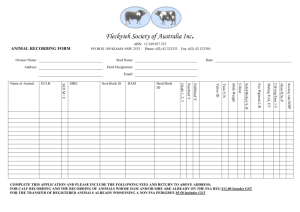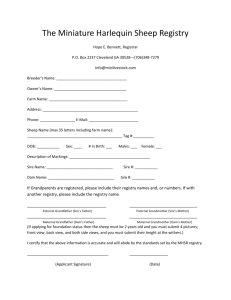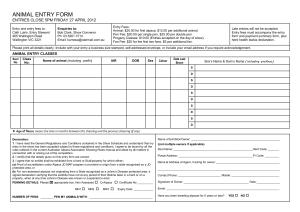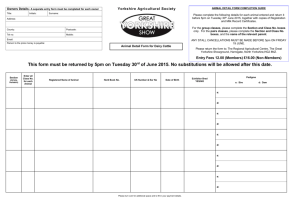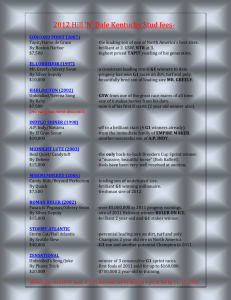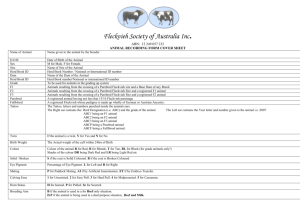regulations - Australian Red Poll Cattle Breeders Incorporated
advertisement
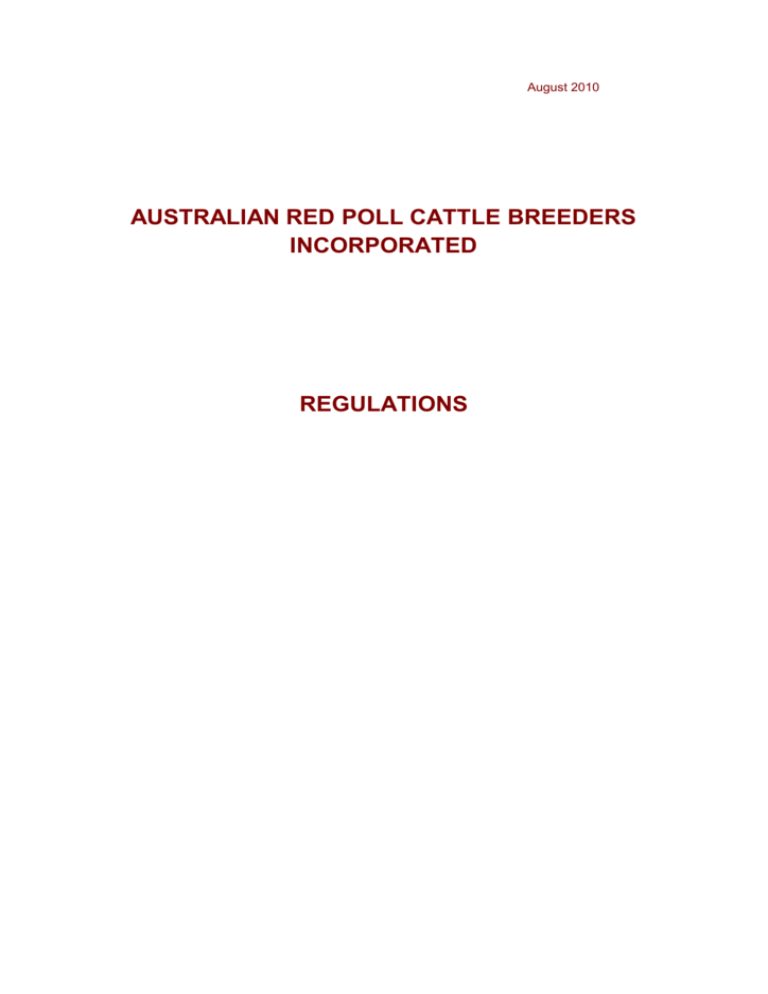
August 2010
AUSTRALIAN RED POLL CATTLE BREEDERS
INCORPORATED
REGULATIONS
INDEX
REGULATIONS
PAGE
1.
Registration of Animals
3
2.
Transfer of Animals
5
3.
Artificial Insemination
5
4.
Embryo Transplant
6
5.
Blood Typing & DNA Profile
7
6.
ARCBA Codes of Practice
7
7.
Breed Standard
8
2
1.
REGISTRATION OF ANIMALS
(a) The Herd Book shall be known as "The Red Poll Herd Book of Australia", and when
referred to in pedigrees shall be denoted by the letters, "R.P.H.B.A.".
(b) Applications for the registration of Red Poll cattle shall be accepted from life members,
financial full members and financial junior members of the ARPCBI. Such applications shall
be accepted:i. On the understanding that the applicant agrees to inspection, if necessary, to pay the
cost of such inspection, and to accept the decision of the National Executive after
receiving its inspector’s report. The Regional Committee shall on the authority of the
National Executive have the power to appoint inspectors to examine stock for tattoo
brands, type and conformation, and may recommend to the National Executive a
rejection of any animal or the cancellation, of any registration in the event of an adverse
report being received from such inspectors,
ii. in the case of junior members who, at the date of the application referred to above, are
under the age of sixteen years, the application form shall be countersigned by a financial
full member. The countersignature shall be regarded as a guarantee by that member of
the fees payable to the ARPCBI in respect to the animals so sought to be registered.
(c) Each application for registration must be made on a printed Form R1 supplied by ARPCBI
and lodged with the Federal Secretary within nine calendar months from the date of birth of
the calf together with the prescribed fees as determined from time to time by the National
Executive. When the entries received are in order the Federal Secretary will record the
registrations, allot the Herd Book numbers and issue a Certificate of Registration for each
animal registered. Certificates of Registration will show such details as the National
Executive shall from time to time determine. If the Federal Secretary should question the
eligibility of any animal submitted for registration, the matter shall be referred to the National
Executive. The onus shall rest with the entrant in all cases of satisfying the National
Executive of the undoubted purity of animals submitted for registration and as to the
correctness of any additional information required. The National Executive shall have
discretionary power to accept or to reject any pedigree without giving any reason for so
doing.
(d) Calves to be submitted for registration within twelve (12) calendar months of birth. Calves
not submitted prior to twelve months but prior to twenty-four (24) months will be accepted
on payment of a late fee as described in the schedule of fees. Calves submitted for
registration after twenty-four (24) months will only be accepted upon payment of an
extraordinary fee as determined by National Executive, and compliance with the standard of
excellence as determined by an appointed ARPCBI inspector.
(e) Every member shall be required to register a separate tattoo brand composed of a letter or
letters and/or figures; lazy letters are acceptable but no symbols or conjoined letters will be
accepted. Each animal bred must be marked therewith together with a separate
identification number within sixty (60) days from date of birth and before being entered in
the Herd Book or sold; such numbers to be applied in order of date of birth. (No fee). No
alteration or clarification of an existing tattoo brand or serial number shall be made without
the breeder first obtaining the approval of National Executive and such alteration or
clarification to be carried out under the supervision of an inspector appointed by National
Executive from the Region concerned.
(f)
Every member shall be required to register a separate stud prefix for use exclusively in
connection with the names of animals bred by him at such fee as the National Executive
shall determine.
(g) The purchaser of a stud shall have no right to the previous owner's stud prefix except with
the written consent of the previous owner and with the approval of the National Executive.
(h) All stock submitted for registration shall conform to the following conditions:
(i) Both sire and dam must be fully registered in the Red Poll Herd Book of Australia.
3
(ii)
In the case of imported animals they must be registered in a Red Poll Herd Book which
is recognised and approved by the National Executive but not in the Grading Registers
of these Herd Books, or
(iii) Both Sire and Dam must be registered in a Red Poll Herd Book which is recognised and
approved by National Executive, although not necessarily the same Herd Book, and not
in the Grading Registers of these Herd Books, or
(iv) Animals which have been graded-up in Australia shall be registered in the Herd Book
when they reach the standard of recorded and/or authenticated purity as set out
hereunder.
(1) The minimum standard required for females is that they, together with their first and
second maternal dams, must all have been sired by fully registered Red Poll bulls.
Such females shall then be accepted for registration at A3 status after having been
inspected and approved for type at the age of three years or more. The inspection
shall be carried out by inspectors appointed by National Executive and the applicant
shall pay such fees for registration of such females as may be specially prescribed
from time to time by the National Executive. Such animals shall carry the letters A3
after their registered number in the Herd Book.
(2) Female progeny of such A3 status females which have been mated to a fully
registered Red Poll bull shall be eligible for full registration provided however that the
first immediately succeeding progeny shall be subject to further inspection and
approval before being fully registered. The applicant shall again pay such special
fees as prescribed from time to time by the National Executive.
(3) Male progeny of such A3 status females, which have been mated to a fully registered
Red Poll bull, will not be eligible for registration.
(4) Male progeny of the first immediately succeeding female progeny of A3 status
females mated to fully registered bulls shall be eligible for full registration on the
recommendation of three inspectors appointed by the National Executive provided
that such male progeny are not less than two years of age at the time of inspection.
The applicant shall pay such fees for registration of such bulls as may be specially
prescribed from time to time by the National Executive.
(5) Any costs associated with inspection of animals for registration under clause (iv) shall
be paid by the applicant.
(i)
Each animal must be named by its breeder and shall be preceded by the breeders stud
prefix. Such name, exclusive of the breeders stud prefix, shall not exceed a total of twenty
two characters. No name that has already appeared in the Herd Book may be duplicated,
and, if this rule is not observed, the National Executive has the right of renaming the animal
if the applicant refuses to do so.
(j)
After its pedigree has been printed in the Herd Book, the name of an animal may not be
changed.
(k) In the case of numerals, such as 2nd, 3rd or 4th, being used, the numerical order thereof
shall be in sequence of date of birth. Such numerals may only be used for animals
intimately related to the animal having a prior numeral as part of its name. Family names
may not be used for other than direct descendants or close relatives of animals bearing
such name. The possessive ('s) may not be used in any name more than once. Names
deemed objectionable by the National Executive on any ground, or names pronounced alike
but spelt differently, may not be used.
(l)
The breeder of an animal is the owner of its dam at date of calving.
(m) The sire and dam of each animal submitted for registration in the Herd Book must be
already registered in the ARPCBI Herd Book or application for their registration must be
accepted before such animal can be registered.
4
(n) In the event of a calf being sired by a bull not the property of the breeder of the calf, a
certificate of service, signed by the owner of the bull, must accompany the entry.
(o) No heifer from a multiple birth containing a bull shall be eligible for exhibition at shows or
sale as a registered animal, until such time as she produces a live calf.
2.
TRANSFER OF ANIMALS
(a) It shall be compulsory upon request of the purchaser for the vendor to officially transfer all
registered stock sold. Such transfers must be made on official record of Ownership
Transfer forms supplied by the ARPCBI showing such information as National Executive
may from time to time determine and should be lodged with the Federal Secretary together
with the prescribed fee, within sixty (60) days from date of sale. Transfers lodged after sixty
(60) days of sale shall only be acceptable at the discretion of National Executive. Omission
from the Official List of Transfers (as updated in each volume of the Herd Book) will
disqualify the progeny of any animal from registration in the name of the transferee and if
any breeder should sell an animal not already registered in the Herd Book it must be
registered by him before the transfer of ownership can be recorded.
(b) On a complaint from a transferee that a vendor has not, by the expiration of 60 days from
the date of purchase of a registered animal, duly completed and lodged an official transfer
form in respect of such animal, such vendor shall forthwith cease to be entitled to vote at
any meeting, be elected to or hold any office, or enter in the Herd Book any progeny born
after the expiry of such sixty days. On receipt of sufficient evidence that a transfer of
ownership of an animal has occurred, National Executive shall, on the application of the
transferee, forthwith register such transfer and may reinstate the rights of the defaulting
vendor on payment of a fee determined by the National Executive.
(c)
Requests regarding the reinstatement and transfer of registered animals, when owned by a
non-member, will be decided upon by the National Executive on a case-by-case basis. In
doing so, the National Executive must ensure all outstanding fees owing to the ARPCBI are
paid and that the animals are inspected by a member approved by the Executive.
3.
ARTIFICIAL INSEMINATION
a) The laws of the relative State of the Commonwealth shall govern the importation and
collection of semen and the sale or other disposition and use of semen in the
insemination of Red Poll females within a State.
b) The National Executive shall open and maintain a register of donor sires and shall
establish rules, which shall control the responsibilities of the owners of the donor sires
and the members using the semen of the donor sires.
c) All calves submitted for registration in the ARPCBI Herd book produced by Artificial
Insemination where the breeder is not an owner of the sire, must be sired by a
registered AI Donor sire.
d) The ARPCBI reserves the right to suspend registration where there is any progeny
defect of any nature whatsoever. Such suspension shall continue until the ARPCBI is
satisfied that all its requirements have been fulfilled and/or that there are no breed
defects of any nature that are not acceptable to the ARPCBI. In the event that the
ARPCBI cannot be satisfied as to its requirements and/or there are breed defects or a
defect that is not acceptable to the ARPCBI then the ARPCBI may cancel the
registration of that animal or any of its progeny in the Herd Book.
e) Ownership of a registered sire shall be limited to a maximum of four owners. Ownership
shares are to be a minimum of 25%. Possession rights and/or percentage of sire sold
must be clearly displayed on the transfer certificate submitted to the ARPCBI.
5
f)
To signify that an animal was got by A.I. the words "Got by A.I." shall be printed in the
ARPCBI's Herd Book following the registration.
g) All AI Donor Sires recorded prior to 01/07/07 owned by active ARPCBI financial
members will be classed as Control Sires. Registered owners of Control Sires may
apply to the National Executive to have their sire listed as an AI Donor Sire.
h) Before calves can be registered as having been got by A.I. from a Control Sire not
presently registered as being owned by the person desiring registration of the calf, it
shall be accompanied by a Certificate of Approval for Registration issued by the owner
of the said sire indicating that all fees and conditions prescribed by the owner of the said
donor sire have been complied with. The owner of a Control sire may apply to the
ARPCBI for the issue of such Certificate of Approval for Registration which he may then
if desired sell to a person desiring registration of a calf got by A.I. from semen of the
said donor sire.
i)
The cost to the owner of a donor sire for the purchase of Certificate of Approval for
Registration will be as from time to time determined by the National Executive.
j)
Any member applying to register calves got by A.I. sired by a Control Sire shall submit Where applicable, the Certificate of Approval for Registration from the owner of the
Control Sire.
Such further particulars as the National Executive may from time to time require.
k) From the 1/07/07 a financial active recording member may apply for a registered male in
the ARPCBI Herdbook to be made an AI Donor Sire.
l)
To record an AI Donor Sire the following requirements must be supplied to the National
Executive;
Sires registered name
Sires Herdbook number
DNA Profile of the sire
Fees as prescribed by the National Executive.
A signed statement by the recording member that the nominated sire fulfils the criteria of
the ARPCBI Standard of Excellence. The National Executive reserves the right to
cancel AI Donor Sire status if the recorded AI Donor Sire is subsequently proven not to
meet the Standard of Excellence.
4. EMBRYO TRANSPLANT
Progeny got by Embryo Transplant will be registered in the records of the ARPCBI provided
that the regulations of the ARPCBI and the Special Regulations as set out hereunder are
complied with.
(a) Approved Form for Embryo Collection
(i) This form is a declaration by the member who is the owner of the donor cow and a
declaration by the Veterinarian or trained technician performing the embryo
transplant.
(ii)
*
*
This form must be returned to the ARPCBI within ninety (90) days of the transplant
operation and be accompanied by a fee as determined by the National Executive
from time to time.
(iii) This form will include (inter alia) Name of donor cow, tattoo number, Herd Book number and blood type or DNA type
as certified by an approved laboratory.
Name of sire used, tattoo number, Herd Book number and blood type or DNA type
as certified by an approved laboratory.
6
*
Name and address of Veterinarian/trained technician performing the transplant
operation.
*
Place and date of transplant operation.
*
Number of embryos collected and the number actually transplanted.
*
Permanent distinguishing marks (tattoo, fire brand or freeze brand) of the
recipient dams.
*
Number and identification of embryos stored.
Any animal got by ET will be eligible for registration in the Herd Book
i. providing the following criteria has been met when applying for Herd Book
Registration:‐
a. The dam and sire are recorded with the Society as donors
b. Blood type or DNA certificates for both sire and dam are recorded with the
Society.
c. If the donor animals are not beneficially owned by the applicant then copies of
the Herd Book certificates are to be attached to the Herd Book application form
together with a service certificate signed by the owner of the donor animals
stating the number and date the embryos were sold to the applicant.
(b) On Calving
Calves got by Embryo Transplant are notified by way of the ARPCBI normal Registration
Forms within the stipulated time. (The form must indicate that the animal has been got
by Embryo Transplant). No calves will be accepted for registration unless the Approved
Form for Embryo Collection has been previously sent to the ARPCBI within the specified
ninety (90) days of the embryo transplant operation and accompanied by the prescribed
fee.
(c) General
(i)
The ARPCBI will accept transfer (sale) of embryos and transfer (sale) of recipient
dams prior to calving PROVIDED THAT the ARPCBI is notified by way of
Application Form for Transfer of Embryo. This form must be returned on
completion by the transferor to the ARPCBI within ninety (90) days of the
transaction and be accompanied by an appropriate fee as determined by the
National Executive.
(ii)
The ARPCBI will accept transfer of donor dam between time of embryo collection
and the ARPCBI recorded birth of calves from such transplant operation provided
that details of all embryo transactions have been lodged with the ARPCBI
(iii) Animals registered in the Herd Book from embryo transplant will be so designated
by the addition of the letters - E.T.
(iv) The same rules to apply to a donor dam as apply to an AI sire.
5. BLOOD TYPING or DNA TYPING
Notwithstanding any previous Regulations, the ARPCBI reserves the right in any
circumstances to request blood typing or DNA typing whether the calf is got by natural
service, embryo transplant or artificial insemination to verify parentage.
6.
ARCBA CODES OF PRACTICE
(a) The Code of Practice - Offers and Sale of Interests in Cattle Genetic Material and Sale of
Cattle was adopted by the Australian Registered Cattle Breeders Association Inc. (ARCBA)
and approved by the Council of ARPCBI (administrative body in place prior to the National
7
Executive) for inclusion in these Regulations 1/4/92. Copy of full document can be obtained
from Federal Secretary.
(b) A second Code of Practice – this being For the Marketing of Beef Cattle Seedstock –
was developed by ARCBA in conjunction with the Beef Improvement Association of
Australia Inc (BIA) during 1996 and 1997. A specific logo for this Code of Practice was also
developed and registered with the Trade Marks office of IP Australia. Use of this logo is
restricted according to the Regulations concerning the use of a Certification Trade Mark
owned by ARCBA and BIA. The Council of ARPCBI (administrative body in place prior to
the National Executive) approved in principle this second Code of Practice on 23/3/97 for
use and adoption by individual members of the ARPCBI Further information and copies of
the appropriate documents can be obtained from the Federal Secretary.
8
7. BREED STANDARD
COLOUR: Colour must be red, deep for preference. A sandy colour is an objection though not a
disqualification. White markings are permissible on females on the udder attachment only, and
on males on the extreme upper part of the scrotum. A white or silver-haired brush of the tail is
permissible.
SIZE: Males: Skeletal or frame size should be medium to large. With good height, a balancing length
and adequate body capacity is required together with depth of rib, substantial bone and a
symmetrical leg size to fit this body.
Females: Skeletal size should be comparative to the male, with ample scale for age (not coarse)
with plenty of length and width, particularly from hips to back.
HEAD: Masculine and strong in the male, feminine and refined in the female. Head should be broad,
of moderate length, and slightly dished. The eyes should be full, wide apart, well hooded and
placid; the nostrils wide and open; the jaws should be wide, deep and strong (not undershot or
overshot). The poll should be well defined with ears well set on the head and of medium size.
There should be no evidence of horns or scurs.
NOSE: The nose should be flesh coloured. Should it be black or blue this is a disqualification. Any
black or blue spots constitute an objection according to their size.
THROAT: Clean and free from excessive loose skin.
NECK: Males: of medium length, muscular, with moderate crest, spreading out to meet the shoulders.
Females: Female's shoulders should be smooth and sloping, well filled behind and not open at
the top.
CHEST: Wide and showing spring of rib cage and depth in proportion.
BRISKET: Obvious, but not excessive, broad and clean with minimum of loose skin.
RIBS: Well sprung from backbone, neatly joined to crops and loins, bones well covered. Rumps long
from hip bone to pin bone, broad level and full. Pin bones should be set wide apart.
HINDQUARTER: Full, thick and muscular showing greatest thickness through stifle area.
TAIL: Should come neatly out of the body and hang at right angles to it.
LEGS: Forelegs well apart and straight with strong cannon bone of moderate length and with muscular
forearm. Hindlegs slightly inclined forward below the hocks with clean strong flat bone. Hocks
correctly set, strong and clean cut. Legs should be well placed on the corners of the body and
relatively wide apart. Length of leg to be in proportion to size and length of the animal.
FEET: Feet should point straight ahead, with short straight toes of equal size and deep heels.
FLESHING: Deep, smooth and firm, without patchiness, with smooth even fat cover.
SKIN: Soft, loose and pliable of moderate thickness covered with good quality fine hair.
SHEATH and SCROTUM: Should not be loose or pendulous. Testicles of moderate to large even
size, and hanging freely without twist, with well developed rudimentary teats in front of the
scrotum.
UDDER: The female's udder should be well developed, being long from front to rear, wide and deep,
but neither pendulous nor fleshy. It should be firmly attached, extending up behind and forward
in front. The quarters should be even, the sole level with no excessive undulation between teats.
The teats should be of medium size, neither too long nor too short, but very slightly tapering, set
evenly in the centre of each quarter of the udder and pointing to the ground.
GENERAL APPEARANCE: The animal must be able to walk freely.
Male: Masculine, alert and active. Ample scale for age with plenty of length and width,
particularly from the hips back; he must be well muscled with an abundance of the most valuable
cuts of meat.
Females: Feminine and alert. Ample scale for age with plenty of length and width, showing
sufficient muscling. She must have a good neat udder.
Steers: Steers entered in purebred classes should comply with the same general breed
standards where applicable.
9
